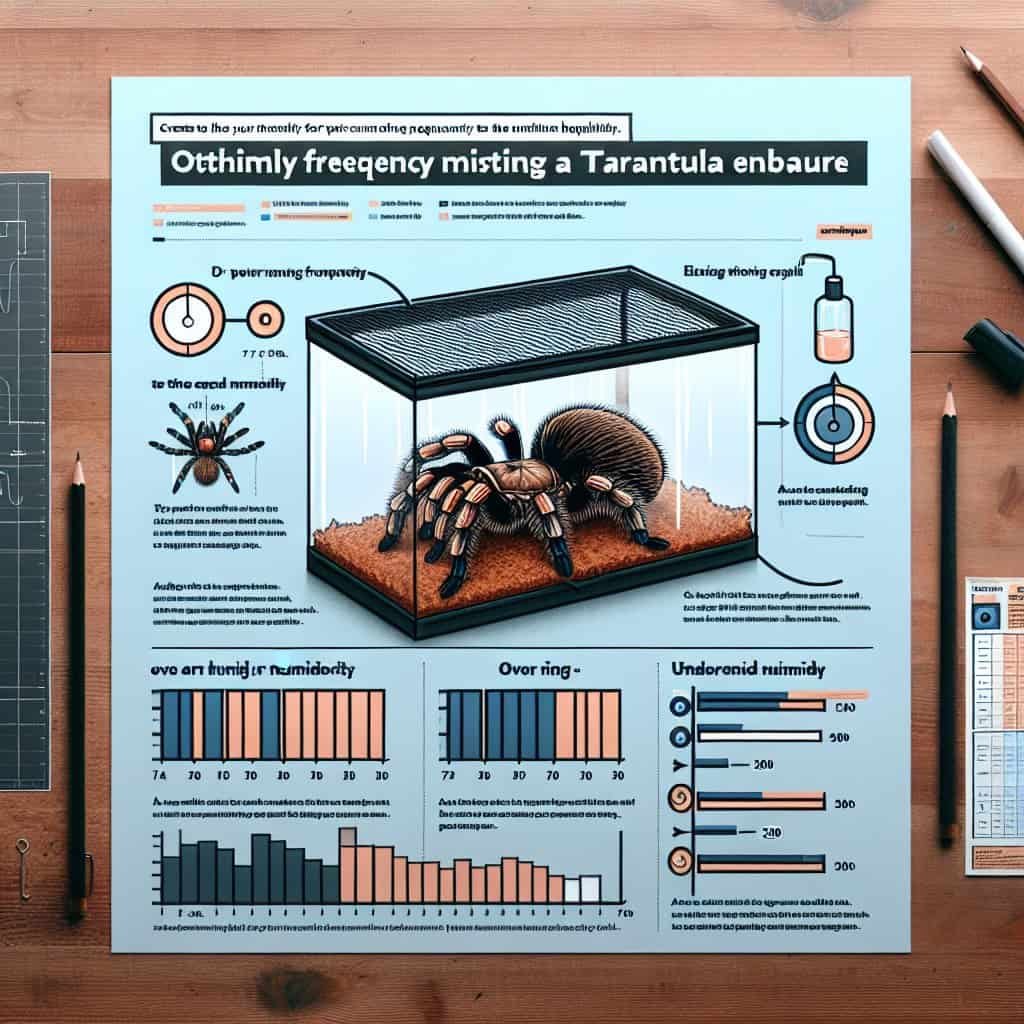If you’re the proud owner of a tarantula, you may be wondering how often you should be misting their enclosure. Providing the right level of humidity is crucial for these fascinating creatures, but finding the perfect balance can be a challenge. In this article, we’ll explore the recommended frequency for misting a tarantula enclosure, ensuring that your eight-legged friend remains happy and healthy in its habitat.
Factors to Consider
When it comes to maintaining the optimal humidity levels in your tarantula enclosure, there are several important factors to consider. These factors include the type of tarantula you own, the type of enclosure you have, the climate in which you live, and the specific humidity requirements of your tarantula species.
Type of Tarantula
Different species of tarantulas have varying humidity requirements. Some species, such as the Brazilian Black tarantula, prefer drier environments, while others, like the Pink toe tarantula, thrive in higher humidity levels. It is crucial to research and understand the specific needs of your tarantula species to ensure you provide the ideal humidity conditions.
Type of Enclosure
The type of enclosure you choose for your tarantula can impact humidity levels. Glass tanks tend to retain moisture better than plastic or mesh enclosures. It is important to select an enclosure that allows for proper ventilation while also maintaining adequate humidity levels.
Climate
The climate in which you reside can also influence the humidity levels in your tarantula enclosure. Areas with naturally high humidity may require less additional misting, while regions with drier climates may necessitate more frequent misting. Consider the average humidity levels in your area when determining the misting frequency for your tarantula’s enclosure.
Humidity Requirements
Finally, it is essential to understand the specific humidity requirements of your tarantula species. Some tarantulas prefer a humidity range of 50-60%, while others may need levels as high as 70-80%. Research the specific needs of your tarantula species to ensure you provide the optimal humidity for its overall health and well-being.
Signs of Inadequate Humidity
Inadequate humidity can have detrimental effects on your tarantula’s health. It is crucial to be able to identify the signs of low humidity to address the issue promptly.
Dry Substrate
One of the most noticeable signs of inadequate humidity is a dry substrate. If the substrate in your tarantula’s enclosure appears dry and powdery, it may indicate that the humidity levels are too low. The substrate should have a slightly moist feel, but not be overly saturated.
Cracked Exoskeleton
Another sign of low humidity is a cracked exoskeleton. When tarantulas experience inadequate humidity, their exoskeleton can become brittle, leading to cracking or peeling. If you notice any cracks or irregularities in your tarantula’s exoskeleton, it may be a sign that you need to increase the humidity levels.
Difficulty Molting
Tarantulas undergo molting, a process where they shed their old exoskeleton to allow for growth. Inadequate humidity can make molting difficult and put your tarantula at risk of becoming stuck in its old exoskeleton. If you notice your tarantula struggling or failing to molt, it may be an indication that the humidity levels need adjustment.

Signs of Excess Humidity
While it’s important to maintain adequate humidity, excessive humidity can also be problematic for tarantulas. Here are some signs to watch out for that may indicate excess humidity levels in the enclosure.
Mold growth
One of the most prominent signs of excess humidity is the growth of mold in the enclosure. Mold thrives in damp environments and can pose serious health risks to your tarantula. If you notice any mold growth in the enclosure, it is crucial to reduce the humidity levels immediately.
Condensation on Glass
Excessive condensation on the glass of the enclosure is another sign that the humidity levels are too high. If the enclosure appears foggy or you can see droplets forming on the glass, it is an indication that the humidity needs to be reduced to prevent respiratory issues and mold growth.
Substrate saturation
If the substrate in the tarantula enclosure feels excessively wet or saturated, it may suggest that the humidity levels are too high. Tarantulas require a balance of moisture, and overly saturated substrate can lead to fungal growth or cause discomfort to your tarantula. Adjusting the misting frequency can help regulate the substrate moisture levels.
Recommended Mist Frequency
Determining the optimal misting frequency for your tarantula enclosure can be a balancing act. Several factors come into play when deciding how often to mist your tarantula’s habitat.
General Guidelines
As a general guideline, misting your tarantula’s enclosure every 2-3 days is a good starting point. However, it is important to remember that this frequency may need adjustments depending on your tarantula’s species, enclosure type, and climate.
Observing Tarantula Behavior
An effective way to gauge the misting frequency is by observing your tarantula’s behavior. If your tarantula frequently seeks out moisture or spends extended periods near the water dish, it may indicate a need for increased humidity. On the other hand, if your tarantula actively avoids areas with high moisture, it may suggest that the humidity levels are too high, and you should reduce the misting frequency.
Trial and Error Approach
Experimenting with misting frequency is key to finding the perfect balance. Start with a conservative misting schedule and monitor how your tarantula responds. Adjust the frequency gradually, taking note of any changes in behavior or signs of inadequate or excess humidity. Over time, you will develop a misting routine that suits your tarantula’s unique needs.

Monitoring Humidity Levels
To maintain optimal humidity levels for your tarantula, it is important to monitor the humidity within the enclosure. Here are a couple of methods you can use to ensure the humidity remains within the desired range.
Hygrometer
A hygrometer is a useful tool for measuring and monitoring the humidity levels in your tarantula enclosure. Place the hygrometer in the enclosure, preferably at the tarantula’s level, to get an accurate reading of the humidity. Regularly check the hygrometer to ensure the humidity remains within the recommended range for your tarantula species.
Checking Substrate Moisture
Another way to monitor humidity levels is by checking the moisture of the substrate. The substrate should feel slightly moist to the touch without being overly wet. Avoid letting the substrate dry out completely or become excessively wet. Regularly inspect the substrate and adjust the misting frequency accordingly.
Alternative Humidity Techniques
While regular misting is a common method to maintain humidity, there are alternative techniques you can incorporate to ensure optimal humidity levels in your tarantula enclosure.
Water Dish
Providing a shallow water dish in the enclosure allows your tarantula to hydrate itself and absorb moisture through its exoskeleton. This can help supplement the humidity levels in the enclosure without relying solely on misting. Ensure the water dish is clean and filled with fresh water regularly.
Spray Bottle
Using a spray bottle is an effective way to increase humidity in specific areas of the enclosure. By lightly misting specific areas, you can create localized humidity zones and provide your tarantula with options to seek out moisture as needed. Be cautious not to overspray and saturate the enclosure.
Misting System
For larger enclosures or if you have multiple tarantulas, a misting system can provide consistent and controlled humidity. Misting systems generally consist of a timer, tubing, and misting nozzles that distribute fine droplets of water throughout the enclosure. These systems help maintain optimal humidity levels without the need for frequent manual misting.

Adjusting Mist Frequency
The misting frequency for your tarantula’s enclosure may need adjustment based on various factors. It is important to consider seasonal changes, tarantula growth and activity, as well as the molting cycle.
Seasonal Changes
Different seasons can bring changes in ambient humidity levels. During seasons with higher humidity, you may need to reduce the misting frequency to avoid excess moisture. Conversely, in drier seasons, you may need to increase the misting frequency to ensure adequate humidity for your tarantula.
Tarantula Growth and Activity
As your tarantula grows, its needs can change. Growing tarantulas may require higher humidity levels, while mature individuals may tolerate slightly drier conditions. Additionally, tarantula activity levels can impact moisture requirements. More active tarantulas may require higher humidity to support their energy expenditure.
Molting Cycle
The molting cycle of a tarantula is a critical time where maintaining proper humidity is paramount. Before molting, tarantulas require increased humidity to facilitate the molting process. You may need to increase the misting frequency to ensure the enclosure’s humidity is suitable and aids in a successful molt.
Avoiding Risks and Pitfalls
While misting your tarantula’s enclosure is crucial for maintaining proper humidity, there are some risks and pitfalls to be aware of.
Over-Misting
Excessive misting can lead to excess humidity, which can create a stagnant or high-moisture environment. This can increase the risk of mold growth, fungal infections, and respiratory issues. Always monitor the humidity levels and adjust the misting frequency accordingly to avoid over-misting.
Under-Misting
On the other hand, insufficient misting can result in low humidity levels, leading to dry substrate, cracked exoskeletons, and difficulties during molting. It is essential to provide adequate moisture without overdoing it. Regularly assess the enclosure’s humidity levels and make adjustments as needed.
Stagnant or High-Moisture Environments
Maintaining humidity levels within the recommended range is crucial to prevent stagnant or high-moisture environments. Stagnant moisture can create a breeding ground for bacteria, mold, and parasites, posing significant health risks to your tarantula. Ensure proper ventilation and avoid excess moisture accumulation.

Consulting Expert Advice
If you are uncertain about maintaining the ideal humidity levels for your tarantula, it is always helpful to seek expert advice. Here are a few sources you can turn to for guidance.
Tarantula Breeders
Tarantula breeders have extensive experience caring for tarantulas and are often knowledgeable about the specific humidity requirements for various tarantula species. They can provide valuable insight and advice on maintaining optimal humidity based on their firsthand experiences.
Tarantula Forums
Online forums dedicated to tarantula enthusiasts provide a platform for sharing experiences and seeking advice. Engaging with the tarantula community can help you gain valuable insights and recommendations regarding humidity maintenance for your specific tarantula species.
Professional Exotic Pet Veterinarians
If you have concerns about the humidity levels in your tarantula enclosure, consulting a professional exotic pet veterinarian is a wise choice. They can offer expert guidance, perform examinations, and provide recommendations tailored to your tarantula’s specific needs.
Conclusion
Maintaining the appropriate humidity levels in your tarantula enclosure is crucial for ensuring the well-being of your pet. By considering factors such as the type of tarantula, enclosure, climate, and specific humidity requirements, you can create an optimal environment for your tarantula to thrive. Regularly monitoring humidity levels, adjusting misting frequency, and seeking expert advice when needed will help you provide the ideal humidity conditions for your tarantula’s health and happiness. Remember, a well-hydrated tarantula is a happy tarantula!

